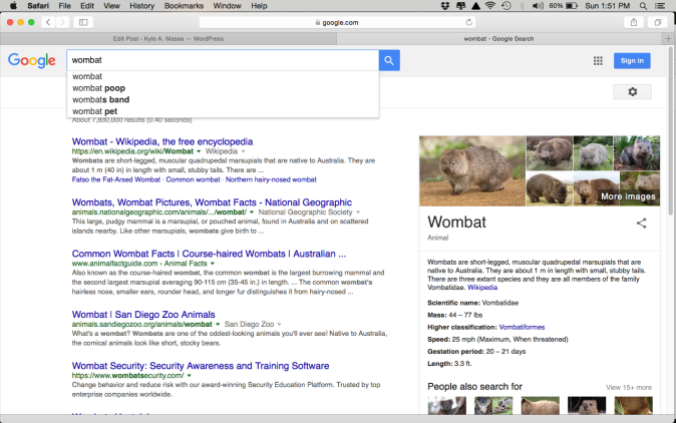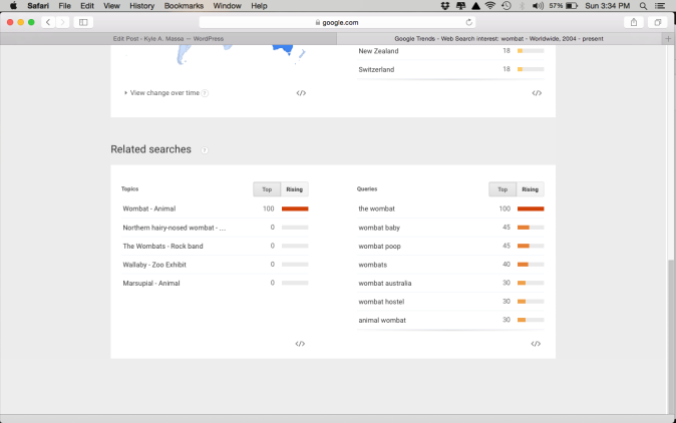
So you’ve decided to start a blog about wombats. I salute you.
It’s a great blog. You’ve got some killer costume ideas for wombats, your favorite baby wombat pics, your top 10 favorite songs by The Wombats. This site is amazing.
Only problem is, you can’t seem to get anyone to visit it. It’s not that the content is poor—everyone loves wombats. It’s just that no matter how good your content is, no one will ever know about it unless they can find it. That’s where SEO comes in.
What is SEO?
SEO is an acronym that stands for “search engine optimization.” It’s just a fancy term for improving your website so that it appears on the first few pages of search engine results. The better your SEO, the more likely folks are going to find your website when they search Google.
How Do I Get Started?
SEO might sound intimidating, but it’s actually pretty easy. Just use words on your website and in your posts that people are likely to search for.
In the case of your wombat blog, your top search term is probably going to be “wombat.” But what else are people searching for when they search for wombats?
As a shortcut, let’s head to Google and type your keyword into the search bar, then see what comes up.

Okay, now we’ve got some good data. Make sure to have some of these terms on the your pages, because these seem to be terms commonly associated with wombats.
Bonus: this is a great way to come up with some post ideas. For example: “Do Wombats Make Good Pets?” Or, even better, “What is Your Wombat’s Poop Telling You?”
Myth: SEO Is About Repeating the Same Words Over and Over
Allow me to digress for a moment. Once upon a time, I was fresh out of college and I was looking for a job—preferably one in writing. I found a company that defined themselves as “reputation management,” something like that. The basic idea was that clients hired them to flood the internet with positive content about the client in order to suppress negative stories that might be floating around the internet.
So yeah. Kinda shady stuff. I didn’t end up working for them.
Anyway, their SEO approach wasn’t the greatest. They were trying to get their stuff on the front page of Google results by packing each post with the client’s name and a few specific keywords repeated over and over again.
At one point, this might’ve worked—posts used to be ranked based on the number of relevant keywords they contained. But search engine sites quickly found that keyword packing generally yielded poor content. After all, one can only read the phrase “wombat poop” so many times before it becomes overwhelming.
The better approach is to find the right keywords, and then place them strategically throughout a webpage. Plus a little more. Let’s take a look at some other tips.
What Are Some of the Best Tools?
Google Trends is a great place to start. Just type in your topic and you’ll get a nifty graph that looks something like this:

This is perfect for tracking the popularity of searches throughout the year. Though nothing really jumps out from this graph, you can see that wombat Google searches were at their peak in August of 2014. That probably means this month will be a good time to post as many wombat stories as possible.
Scroll to the bottom and you’ll find related searches. This is another goldmine for keyword data—sort of like our search bar trick from before, only wombattier.

The more of these terms you include in your pages, the better your results will be. But remember: don’t force keywords into a post if they lessen the quality. SEO will help people find your content, but if they don’t like what they find, they won’t come back.
What Else?
Here are some other random SEO tips:
- Use alt text on every image – As we know, Google indexes search results based on words. So if you’ve got an image with no words associated with it, Google won’t quite know what to do with it. When you upload your images, help Google out by entering alt text that describes the picture.
- Link to Other Pages – Google places greater value on pages that have more links pointing to them. Obviously, you can’t force other people to link to your stuff, but if you write good content, they’re more likely to do so. Furthermore, if you link your own posts to each other, that still counts. Just don’t go overboard—at most three per post should do the trick.
- Use search keywords in the title of your post – This is one of the first places Google looks when it’s indexing results for a search. It’s essential to have your top terms right there, front and center.
Try these tips and see how they work for you. Also, if you see a wombat, pet it.



